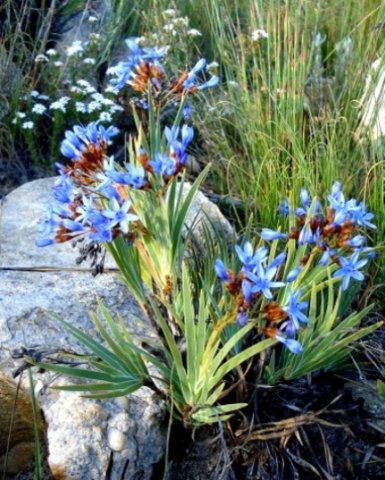Nivenia stokoei

Author: Ivan Lätti
Photographer: Judd Kirkel Welwitch
Nivenia stokoei, also known as Stokoe’s bush iris or blue stars, was named for Thomas Stokoe, mountaineer and plant collector. He discovered and first collected this plant in 1924 in the Kogelberg.
The small shrub reaches heights up to 1,5 m, taller in sheltered areas, shorter where exposed. The plants may last for a long time in undisturbed, usually meaning unburned fynbos. Some of the bigger specimens have been estimated to be around 150 years old.
The genus Stokoei, the woody irises, comprises 10 species, all in the fynbos. These woody plants grow from woody underground caudices that are resistant to fire, meaning that the plants resprout after fire.
Clusters of widely open six-petalled blue flowers on long narrow perianth tubes appear from January to March. They are pollinated by long-tongued bees and some flies.
The species distribution is small, restricted in the Western Cape to an area in the Kogelberg near Bettys Bay and Kleinmond, mostly in the protected land of the Kogelberg Biosphere Reserve. The photo was taken in the Harold Porter National Botanical Garden in October, long before the normal blooming season.
The habitat is sandstone ridges covered in fynbos. Only ten populations of N. stokoei are known to exist, but they are stable in the secure area of a cared for Reserve. Not all rare plants are that fortunate.
Conservation also occurs when plants are cultivated and maintained in botanical gardens, nurseries and private gardens. First prize is always, however, the survival of a species on a sustained basis in its natural habitat. This must be the objective of concerned citizens that value biodiversity (Information obtained from a Kirstenbosch signboard; Manning, 2009; Bean and Johns, 2005; iNaturalist; http://pza.sanbi.org; http://redlist.sanbi.org).

